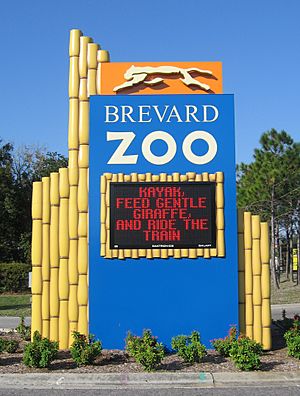Brevard Zoo facts for kids

Brevard Zoo Monument Sign at Entrance
|
|
| Date opened | March 26, 1994 |
|---|---|
| Location | 8225 North Wickham Road Melbourne, Florida, U.S. |
| Land area | 50 acres (20.2 ha) |
| Coordinates | 28°13′30″N 80°42′50″W / 28.225089°N 80.713978°W |
| No. of animals | 900 |
| No. of species | 195 |
| Annual visitors | 464,000 (2015) |
| Memberships | AZA |
Brevard Zoo is a super cool place in Melbourne, Florida, United States! It's a non-profit zoo that's home to over 900 animals. These animals represent more than 195 different species. You can see creatures from Florida, South America, Africa, Asia, and Australia.
The zoo offers lots of fun activities for visitors. You can enjoy animal feedings, go on kayak tours, or even take a train ride. There's also an exciting adventure course called Treetop Trek. The zoo has even featured dinosaur exhibits in the past! Brevard Zoo is officially recognized by the Association of Zoos and Aquariums, which means it meets high standards for animal care.
The zoo is divided into four main areas, called "loops." These are Expedition Africa, Lands of Change: Australia and Beyond, Wild Florida, and Rainforest Revealed. You can find these loops off the main path that goes around the flamingo pond.
Contents
History of Brevard Zoo
The idea for Brevard Zoo started in 1986. A group called the East Coast Zoological Society of Florida, Inc. (ECZS) wanted to build a special place. Their goal was to create a "conversation hub." This would be a place where people could learn about animals and nature. It would also be a spot to connect with the amazing variety of life on our planet.
Building the zoo began in 1992. Over 16,000 people came together to help! This huge effort was called "The World's Largest Volunteer Community Build." The Brevard Zoo officially opened its doors on March 26, 1994.
In 2007, the zoo had a record number of visitors. Over 328,000 people came to explore the zoo that year. The zoo often updates its exhibits to make them even better. For example, in 2017, the Australia and Asia exhibits were renovated. They reopened as "Lands of Change: Australia and Beyond." Then, in 2019, the La Selva exhibits were updated. They reopened as "Rainforest Revealed."
Explore the Park Areas
Wildlife Detective Training Academy
The Wildlife Detective Training Academy, or WDTA, is a special building for younger children. It has terrariums with many of the zoo's reptiles, amphibians, and arthropods. You might even see a few small mammals like chinchillas.
This area also has fun, hands-on activities. Kids can dig for bones in a sand pit, like a detective at an animal "crime scene." There's also an animal hospital area. Here, children can learn about animal bodies and how vets help sick animals. The WDTA even has a new mystery each month. Kids can investigate and find clues throughout the zoo!
Expedition Africa
Expedition Africa lets you go kayaking right inside the zoo! Trained staff lead the kayak trips. They share interesting facts as you paddle past African-themed exhibits. You'll see amazing animals like giraffes, white rhinos, and ostriches. Look out for impalas, scimitar-horned oryx, camels, cheetahs, and zebras.
After your kayak trip, you can climb to an observation platform. From there, you can feed the giraffes at eye-level! Siamang gibbons live between the entrances to Expedition Africa and Lands of Change. The zoo also helps protect scimitar oryx. This type of oryx is extinct in the wild, meaning it no longer lives freely in nature.
Lands of Change: Australia and Beyond
This area is all about animals from Australia and Oceania. You can find red kangaroos, emus, and wallabys here. Lands of Change also has a free-flight aviary. In the aviary, you can even feed colorful rainbow lorikeets!
The aviary is home to many birds, including galahs, lorikeets, cockatiels, kookaburras, and shelducks. It's split into two parts: the "lorikeet side" and the "cockatiel side." Right across from the aviary is a special kangaroo walkabout. Here, you can get very close to the zoo's kangaroos and emus. This area also has solar panel "trees." They provide shade for the kangaroos and power for the komodo dragon house!
Wild Florida
In the Wild Florida loop, you'll see animals that live right here in North America. Look for river otters, alligators, crocodiles, and bobcats. This area also has a pack of the rare red wolf. These wolves are nearly extinct, so it's a special chance to see them. Sometimes, you can even watch animal feedings here. There's also a spot to kayak into the wetlands at the back of this loop.
Rainforest Revealed
This loop used to be called La Selva. It's now known as Rainforest Revealed. Here, you'll find the zoo's amazing jaguars. You can also spot cotton-top tamarins and golden-headed lion tamarins. Other animals include green iguanas, a Baird's tapir, a family of capybara, and a Hoffmann's two-toed sloth.
There's also a vulture exhibit with king vultures, turkey vultures, and black vultures. You can often watch vulture feedings and demonstrations here.
Paws On
Paws On is a fantastic area designed for children of all ages. It has an updated Contact Yard, which is a petting zoo. Here, you can meet alpacas, pygmy goats, an African spurred tortoise, and even armadillos.
Paws On also features a shallow swimming area, perfect for cooling off. There's an aquarium that looks like the nearby Indian River Lagoon. You can see fish like Tarpons and stingrays here. Don't miss the touch tank! In the touch tank, you can gently feel horseshoe crabs, hermit crabs, and Florida crown conchs. There's also a pizzeria for snacks and other fun attractions.
Gallery





















